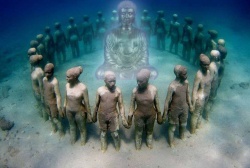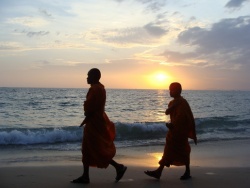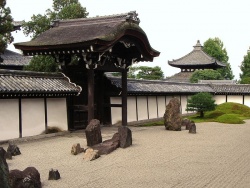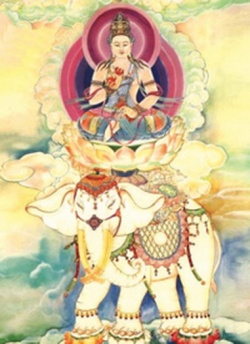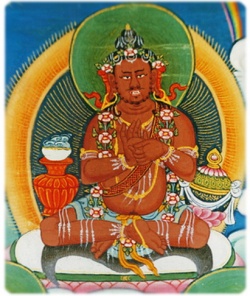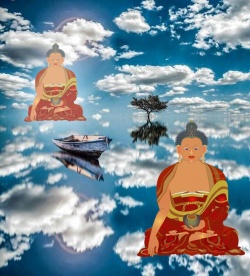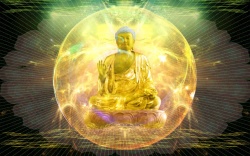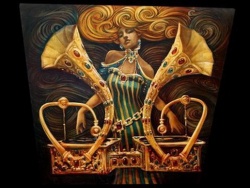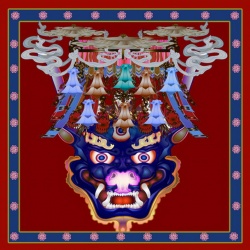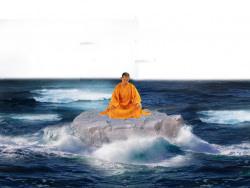Alaya – The Universal Soul
Alaya – The Universal Soul
Alaya
What is Alaya? Many times we ask questions of others, expecting them to shed some light for us on various principles and teachings of Theosophy, whereas in fact we could discover the answers just as satisfactorily – if not moreso – for ourselves, through careful and meditative study.
“Alaya” is a Sanskrit term which appears in “The Secret Doctrine” and “The Voice of the Silence” predominantly.
The ninth sloka of the first stanza from the Secret Book of Dzyan given in Volume 1 of “The Secret Doctrine” states that during the “Night of the Universe,” the Maha-Pralaya or Universal Pralaya, “THE ALAYA OF THE UNIVERSE WAS IN PARAMARTHA.”
When H.P. Blavatsky refers to this verse later on, she includes some explanatory words in parentheses and writes it like this:
“BUT WHERE WAS THE DANGMA WHEN THE ALAYA OF THE UNIVERSE (Soul as the basis of all, Anima Mundi) WAS IN PARAMARTHA (Absolute Being and Consciousness which are Absolute Non-Being and Unconsciousness)…”
“Alaya means latent,” says HPB in “The Secret Doctrine Commentaries,” continuing, “At the end of Manvantara, when Pralaya sets in, certainly the Alaya will become Laya and fall into nothing. There will be the one Great Breath only.”
But what is this Alaya which, like everything else, is eventually reabsorbed into the Absolute at the end of one Universal Life Cycle, to be outbreathed into manifestation once more at the dawn of the next? We read in “The Secret Doctrine” that “The two terms “Alaya” and “Paramartha” have been the causes of dividing schools and splitting the truth into more different aspects than any other mystic terms.”
We should understand that Alaya is a term and concept which originates with the Yogacharya School (now often written as “Yogācāra”) of Buddhist philosophy. The “Yogacharya School” literally means “Yoga Practice School” but this refers to a high and truly philosophical form of mental and spiritual yoga, not any kind of bodily or physical yoga practices.
The Yogacharya school began in India and is part of Mahayana Buddhism. In the Buddhism of Tibet, where the Yogacharya teaching gained its strongest and most enduring ground, the two main philosophical viewpoints present in the various schools and branches of Buddhism are the Yogacharya and the Prasangika-Madhyamika. The two are quite antithetical, since the Madhyamikas seem almost obsessed with the theme of emptiness and insist that the ultimate nature of everything is emptiness, that there is nothing beyond emptiness, and that even this emptiness is empty of emptiness itself!
HPB has referred to them as “the great deniers,” “teaching a system of sophistic nihilism,” and describes their doctrines and conclusions as “exoteric travesties.”
The Prasangika-Madhyamika philosophy is the prevailing and predominant one in Tibetan Buddhism today, with the Yogacharya perspective now relegated to a back seat or, at best, insipidly blended with certain forms of Prasangika-Madhyamika. Ironically, the Gelugpas – the “Yellow Hats” to whom the Dalai Lama and Panchen Lama belong and with whom HPB and the Masters have specifically identified themselves – hold exclusively in their publicly known teachings to the Prasangika-Madhyamika. It must be the case then that there is a definite and almost entirely unknown esoteric undercurrent amongst the Gelugpas.
For more information in this regard, please see the article titled The Great Tsong Kha-pa.
Most exoteric and generally accepted historical sources trace the Yogacharyas back to Aryasanga (often just referred to as Asanga) and his half-brother Vasubandhu, saying that they lived and founded this school or system of philosophy sometime around the 5th century A.D., i.e. around 1,000 years after the time of Buddha.
Some of Aryasanga’s writings were attributed to the Bodhisattva Maitreya – the next Buddha – as they were said to have been dictated by him during Aryasanga’s journeys into higher levels of consciousness.
Some of today’s scholars and researchers believe that Maitreya was actually Aryasanga’s face to face teacher on the physical plane, with some of them identifying him with a mysterious individual known as Maitreyanatha (literally “Lord Maitreya”) about whom next to nothing is known except that he was said to come from the Kingdom of Shamballa. There are some contemporary writers who believe that this Maitreya was the real founder of the Yogacharya School.
HPB once wrote that, “Chagpa-Thog-mad is the Tibetan name of Aryasanga, the founder of the Yogacharya or Naljorchodpa School. This Sage and Initiate is said to have been taught “Wisdom” by Maitreya Buddha Himself, the Buddha of the Sixth Race, at Tushita (a celestial region presided over by Him), and as having received from Him the five books of Champaitchos-nga. The Secret Doctrine teaches, however, that he came from Dejung, or Shambhalla, called the “source of happiness” (“wisdom-acquired”) and declared by some Orientalists to be a “fabulous” place.”
She provides, however, interesting and important information about Aryasanga and the Yogacharya School which is not to be found elsewhere.
In the “Theosophical Glossary” she tells us that actually “there are two Yogacharya Schools, one esoteric, the other popular.” Aryasanga was “the Founder of the first Yogacharya School” and “This Arhat, a direct disciple of Gautama the Buddha, is most unaccountably mixed up and confounded with a personage of the same name, who is said to have lived in Ayodhya (Oude) about the fifth or sixth century of our era.”
She goes on to explain that the original Aryasanga (described in “The Secret Doctrine” as “a pre-Christian Adept and founder of a Buddhist esoteric school”) was the founder of “the lofty system of the early Yogacharya school of pure Buddhism, which is neither northern nor southern, but absolutely esoteric” and that “none of the genuine Yogacharya books (the Narjol chodpa) have ever been made public or marketable.”
The entry in the “Theosophical Glossary” for “Maitreya” reads virtually identically to that for “Aryasangha” since we read that “The fact is that Maitreya was a follower of Buddha, a well-known Arhat … and that he was the founder of an esoteric philosophical school.” Perhaps we are thus to assume that Aryasanga and Maitreya were actually one and the same person? We can speculate but speculation rarely leads to definite knowledge.
However that may be, HPB continues by talking about the later Aryasanga – that “personage of the same name, who is said to have lived in Ayodhya (Oude) about the fifth or sixth century of our era” – and says that he “taught Tantrika worship in addition to the Yogacharya system. Those who sought to make it popular, claimed that he was the same Aryasangha, that had been a follower of Shakyamuni [i.e. Buddha), and that he was 1,000 years old. … one finds in the Yogacharya Bhumi Shastra of the pseudo-Aryasangha a great deal from the older system, into the tenets of which he may have been initiated. It is, however, so mixed up with Sivaism and Tantrika magic and superstitions, that the work defeats its own end, notwithstanding its remarkable dialectical subtilty.”
We therefore find it said that “the fundamental tenets of the Yogacharya system” became “so disfigured by the Ayodhyan imitator” and that “the doctrines of the latter … compiled and glossed … in the sixth century of our era, and his mystic tantras and mantras, his formularies, litanies, spells and mudras, would certainly, if attempted without a Guru, serve rather purposes of sorcery and black magic than real Yoga.”
Since there is at no present no historical evidence available to support or confirm the above details and assertions, they are dismissed by scholars and historians as untrue. They like to think, of course, that no-one could possibly know more than they do or have access to information and records which are closed and inaccessible for the general public.
Thus while such people will view HPB’s words as mistaken or fantastical, students of Theosophy will recognise that what she said was based on KNOWLEDGE; both her own and that of the Masters. For although it is never specifically stated outright, there are many hints and much evidence scattered throughout the Theosophical literature – and especially in the “Theosophical Glossary” – to indicate that the Masters, Adepts, and Initiates of the Trans-Himalayan Brotherhood belong to the secret and esoteric Yogacharya School of pure Buddhism.
In “Transactions of the Blavatsky Lodge,” a student, referring to the exoteric and publicly known Yogacharya teaching, asks HPB by means of suggestion whether it is the case that Theosophy teaches “the same doctrines as the Yogacharya School?” to which the answer is given, “Not quite. But let us go on.”
Even more indicative than this, even more specific than the followers of the Masters’ philosophy being described as “Occult students of the Aryasanga School” on p. 69 of the first volume of “The Secret Doctrine,” is the direct admission in her article “Old Philosophers and Modern Critics” that the phraseology of the Stanzas from the Secret Book of Dzyan – which form the basis of both volumes of “The Secret Doctrine” – is that of “the Esoteric Yogacharyas.”
In the exoteric and publicly known Yogacharya philosophy – which in the eyes of misguided scholars is the only form of the Yogacharya philosophy – the term “Ashta-vijnana” (also found in one of the Master Koot Hoomi’s letters in “The Mahatma Letters”) is used to refer to the total of eight states of consciousness in the human being, the eighth and highest of which is Alaya-vijnana, the source, origin, and substratum of all the others, and which is also considered to be “the receptacle or totality of Consciousness both absolute and relative.”
Alaya-vijnana (pronounced “Vinyana”) is variously translated as “Storehouse Consciousness,” “Causal Consciousness,” “Base Consciousness,” and called “Mula-vijnana” meaning “Root Consciousness.” Western “experts” on the Yogacharya system all seem to differ somewhat in their understanding of it but it seems to be implied that all Karmic seeds are stored in an individual’s Alaya-vijnana and that in this sense it becomes the cause of continued reincarnation, until enlightenment is reached.
Students of the Advaita Vedanta philosophy of Hinduism may see some parallels between this and their doctrine of the Causal Body, called Karana Sharira in Sanskrit.
The esoteric Yogacharya teachings regarding Alaya are obviously different and more extensive than this in a number of respects. On pages 48 to 49 of the first volume of “The Secret Doctrine” we read:
“Alaya is literally the “Soul of the World” or Anima Mundi, the “Over-Soul” of Emerson, and according to esoteric teaching it changes periodically its nature. Alaya, though eternal and changeless in its inner essence on the planes which are unreachable by either men or Cosmic Gods (Dhyani Buddhas), alters during the active life-period with respect to the lower planes, ours included. During that time not only the Dhyani-Buddhas are one with Alaya in Soul and Essence, but even the man strong in the Yoga (mystic meditation) “is able to merge his soul with it” (Aryasanga, the Bumapa school). This is not Nirvana, but a condition next to it.”
“The Yogacharyas (of the Mahayana school) say that Alaya is the personification of the Voidness, and yet Alaya (Nyingpo and Tsang in Tibetan) is the basis of every visible and invisible thing, and that, though it is eternal and immutable in its essence, it reflects itself in every object of the Universe “like the moon in clear tranquil water”…”
“But what is the belief of the inner esoteric Schools? the reader may ask. What are the doctrines taught on this subject by the Esoteric “Buddhists”? With them “Alaya” has a double and even a triple meaning. In the Yogacharya system of the contemplative Mahayana school, Alaya is both the Universal Soul (Anima Mundi) and the Self of a progressed adept. “He who is strong in the Yoga can introduce at will his Alaya by means of meditation into the true Nature of Existence.” The “Alaya has an absolute eternal existence,” says Aryasanga – the rival of Nagarjuna.”
In her entry for “Alaya” in the “Theosophical Glossary,” HPB defines it as “The Universal Soul” and adds that it is “Identical with Akasha in its mystic sense, and with Mulaprakriti, in its essence, as it is the basis or root of all things.”
Her deeply esoteric article “Psychic and Noetic Action” speaks of the Reincarnating Ego, the Higher Manas, in the human being, and says that “the Higher Mind-Entity – the permanent and the immortal – is of the divine homogeneous essence of “Alaya-Akasha,” or Mahat.” Mahat, literally meaning “The Great,” is a Hindu term for the Universal Mind and it is taught in Theosophy that every human mind is a ray of that Divine Universal Mind and of the same intrinsic essence as It.
As the Universal Soul, Alaya is the Universal Consciousness, “the basis or root of all things,” “the basis of every visible and invisible thing,” “eternal and immutable in its essence” and yet reflecting itself “in every object of the Universe.” But the Universal Soul is not the same as the ONE Supreme Absolute Reality. The Absolute is that Paramartha in which “the Alaya of the Universe” lies latent during the unimaginably lengthy period of Universal Pralaya.
Alaya is the Universal Logos. It radiates forth from the Absoluteness of Paramartha (regardless of whether we refer to It as Paramartha, Adi-Buddhi, Adi-Budha, Brahman, Parabrahm, Ain-Soph, or anything else) at the dawn of each Maha-Manvantara and proceeds to become the Living Universe itself. The Universal Soul, the Universal Logos, is the Universal Life. It will be seen that the Masters use the term “Avalokiteshvara” (which they define esoterically as “Self-Existent Lordliness” as opposed to the general exoteric interpretation of the word as “The Lord who Sees”) in exactly the same way and as a synonym for Alaya.
As the Rig Veda scripture of Hinduism famously declares, “Truth is ONE, though the Sages call it by many names.” However, although there is only One Truth, this does not mean that everything is Truth. The concept of the Logos, like so many other things, has been seriously distorted and twisted beyond all recognition in the pseudo-Theosophy of the likes of Alice Bailey, C.W. Leadbeater, and Annie Besant. We would request that any of our readers whose “knowledge” is derived from the books of those “teachers” read our article Understanding the Logos so as to avoid seriously misunderstanding the contents of this present article.
HPB said that in the Esoteric Philosophy Alaya has a triple meaning. First, it is the Anima Mundi, which although literally meaning “World Soul” has always been used in philosophy to indicate the “Soul of the Universe”; second, it is a name which can be applied to the Higher and Spiritual Ego of every individual, not only that of “a progressed adept”; and its third meaning is supplied by the Master K.H. in “The Mahatma Letters” when he says that the vision and perception of the great majority of “seers” is “vision imperfect and deceptive because untrained and non-guided by Alaya Vynyana (hidden knowledge).”
The “Venerable Chohan-Lama … than whom no one in Tibet is more deeply versed in the science of esoteric and exoteric Buddhism” once wrote part of an article for HPB, which was published under the title of “Tibetan Teachings.” Judging from the description given of him, as well as the tone and phraseology of his writing, it would seem that this individual was the same as the Maha Chohan, the venerable Master of the Masters and the Chief of the Trans-Himalayan Brotherhood, whose famous and important letter can be read by clicking here.
He says in that article, “In the book known as the Avatamsaka Sutra, in the section on ‘the Supreme Atman – Self – as manifested in the character of the Arhats and Pratyeka Buddhas,’ it is stated that ‘Because from the beginning, all sentient creatures have confused the truth, and embraced the false; therefore has there come into existence a hidden knowledge called Alaya Vijnana.’ ‘Who is in the possession of the true hidden knowledge?’ ‘The great teachers of the Snowy Mountain,’ is the response in The Book of Law.”
Later he continues, “Very true, our Masters teach us ‘that immortality is conditional,’ and that the chances of an adept who has become a proficient in the Alaya Vijnana, the acme of wisdom, are tenfold greater than those of one who, being ignorant of the potentialities centred within his Self, allows them to remain dormant and undisturbed until it is too late to awake them in this life.”
Some very beautiful and inspirational things are said regarding Alaya in the book “The Voice of the Silence” translated by H.P. Blavatsky from the esoteric Buddhist text “The Book of the Golden Precepts” which she says is generally found in centres where Yogacharya schools are established, in Tibet and surrounding regions.
Her book – which has been praised and endorsed by leading figures in the world of Buddhism, including the current Dalai Lama, the ninth Panchen Lama, and the famed Buddhist expert D.T. Suzuki – consists of three “fragments” from the original text and it is in the second and third of these, titled “The Two Paths” and “The Seven Portals” respectively, that the following references to Alaya occur…
- “Alas, alas, that all men should possess Alaya, be one with the great Soul, and that possessing it, Alaya should so little avail them!
“Behold how like the moon, reflected in the tranquil waves, Alaya is reflected by the small and by the great, is mirrored in the tiniest atoms, yet fails to reach the heart of all. Alas, that so few men should profit by the gift, the priceless boon of learning truth, the right perception of existing things, the Knowledge of the non-existent!”
- “Of teachers there are many; the MASTER-SOUL is one, Alaya, the Universal Soul. Live in that MASTER as ITS ray in thee. Live in thy fellows as they live in IT.”
- “Thou hast to saturate thyself with pure Alaya, become as one with Nature’s Soul-Thought. At one with it thou art invincible; in separation, thou becomest the playground of Samvriti, origin of all the world’s delusions.
“All is impermanent in man except the pure bright essence of Alaya. Man is its crystal ray; a beam of light immaculate within, a form of clay material upon the lower surface. That beam is thy life-guide and thy true Self, the Watcher and the silent Thinker, the victim of thy lower Self. Thy Soul cannot be hurt but through thy erring body; control and master both, and thou art safe when crossing to the nearing “Gate of Balance”.”
- “Know that the stream of superhuman knowledge and the Deva-Wisdom thou hast won, must, from thyself, the channel of Alaya, be poured forth into another bed.”
- “Compassion is no attribute. It is the LAW of LAWS – eternal Harmony, Alaya’s SELF; a shoreless universal essence, the light of everlasting Right, and fitness of all things, the law of love eternal.
“The more thou dost become at one with it, thy being melted in its BEING, the more thy Soul unites with that which IS, the more thou wilt become COMPASSION ABSOLUTE.
“Such is the Arya Path, Path of the Buddhas of perfection.”
As the original and genuine Aryasanga was “an Arhat, a direct disciple of Gautama the Buddha,” it stands to reason that the teachings of the “absolutely esoteric” Yogacharya School of “pure Buddhism” which he founded – of which we can safely assume that only a small portion is presented in the Theosophical teachings – are representative of the secret teachings of Buddha himself.
“There is an esoteric doctrine, a soul-ennobling philosophy, behind the outward body of ecclesiastical Buddhism,” says HPB in the article “The Theosophical Society: Its Mission and Its Future,” “…This secret system was taught to the Arhats alone, generally in the Saptaparna (Mahavansa’s Sattapani) cave … near the Mount Baibhar (in Pali Webhara), in Rajagriha, the ancient capital of Maghada, by the Lord Buddha himself, between the hours of Dhyana (or mystic contemplation). It is from this cave … that the Arhats initiated into the Secret Wisdom carried away their learning and knowledge beyond the Himalayan range, wherein the Secret Doctrine is taught to this day.”
As for herself, she remarks in that same article that she “is undeniably a Buddhist – i.e., a follower of the esoteric school of the great “Light of Asia”,” but that neither Theosophy nor the Theosophical Movement are to be confused with the religion of Buddhism. If the Movement “has a Buddhist colouring [it is] simply because that religion, or rather philosophy, approaches more nearly to the TRUTH (the secret wisdom) than does any other exoteric form of belief. Hence the close connexion between the two.”
“While the Southern Buddhists [i.e. those of the Theravada School) have no idea of the existence of an Esoteric Doctrine – enshrined like a pearl within the shell of every religion – the Chinese and the Tibetans have preserved numerous records of the fact,” she states, adding, “But it is only in the Trans-Himalayan fastnesses – loosely called Tibet – in the most inaccessible spots of desert and mountain, that the Esoteric “Good Law” – the “Heart’s Seal” – lives to the present day in all its pristine purity.”
Many Buddhists may and do deny this, yet HPB maintains that the members of this Trans-Himalayan Esoteric Brotherhood are “the “direct followers” of Gautama the Buddha” and quotes a prophecy which refers to them as “those who are to be denied by His Church for the next cycle” but only for the next cycle, since eventually the truth will be known to all.
It seems that some Theosophists make the rather naive mistake of thinking that “Trans-Himalayan” is literally the actual name of the Masters’ esoteric School and Brotherhood. It is merely a geographical designation, for it is in the Trans-Himalayan region that the Esoteric Yogacharya School has its base and centre.
May we saturate ourselves with pure Alaya, the bright and immaculate ray of the Universal Light within us, and allow it to reach to our very heart of hearts.
